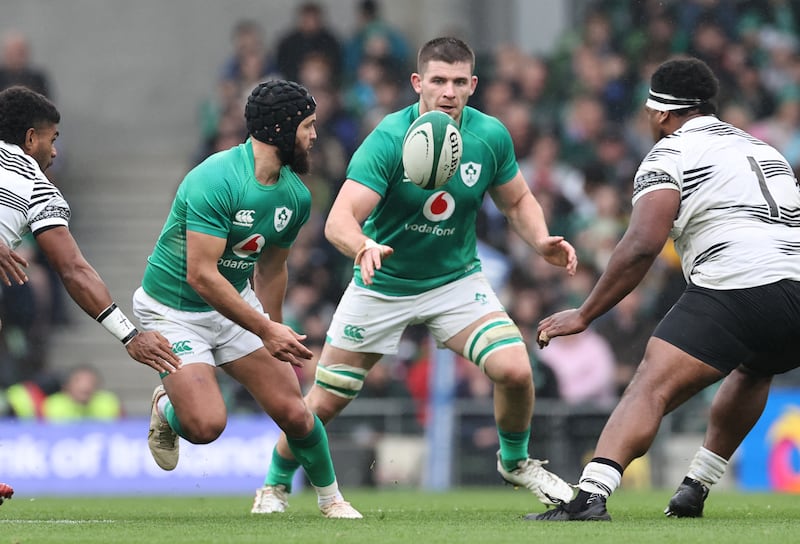Less than five years ago at Stade de France in St Denis – the northern suburb of Paris where Ireland will be based for the latter stages of their 2023 World Cup Pool B matches and the knock-out phase of the tournament – Ireland are losing to France.
It is the first round of matches in the 2018 Six Nations Championship. France are leading 13-12 after 77 minutes. Earning a penalty, French kicker Anthony Belleau lines up his tee before sliding the ball wide of the posts. A lifeline for Ireland.
Ireland secure possession at the restart with 2½ half minutes of the match remaining. However, the team cannot push back the French defence. A minute later and Ireland are still banging against blue shirts but struggling to get any depth into the French half of the pitch.
Recycle after recycle, the match ticks down to the closing seconds and outhalf Johnny Sexton, in desperation mode, crossfield kicks right to Keith Earls, who darts down pitch gaining yards. He feeds the ball back for phase 25.
Former Wales captain and match commentator Eddie Butler, who died suddenly in 2022, remarks on the play.
“Ireland now deep in the French half. Ten more yards and they will probably be in drop goal range. Sexton is down though. The drop kick expert is down on the ground . . . back on his feet now.”
At phase 32 Ireland continue to be knocked back but remain punching just inside the French half, making little impact on territory. On phase 41, after an astonishing period of disciplined ball retention by Ireland, Conor Murray is seen glancing back to look for his outhalf.
He picks out Sexton and delivers the ball. Adding to his four penalties, Sexton dropkicks from 45 metres out. The time on the clock is 82:47 and it is the last play of the match.
The ball sails over as French players fall to their knees crushed and exhausted. Ireland win 13-15 taking the first step towards their third ever Grand Slam win.
That year it was Murray at scrumhalf, this year it is Jamison Gibson-Park and Sexton remains in place. With the World Cup speeding down the track, the question remains whether Andy Farrell’s Irish team can win a World Cup if those pressure points come under stress, if the current halfbacks are not in place in France.
If Gibson-Park and Sexton are injured before the tournament or during play in France, do Ireland’s World Cup chances vanish with them? Is that how fragile the hold is on Irish ambition?
The point of 2018 is that Sexton is a player who has shown he can play the big moments, take physical and mental responsibility. That ability is a matter of personality and mindset. Sexton also dropkicked a goal from the halfway line in the 2009 Heineken Cup final against Leicester.
That’s 13 years ago. Yet, here he is with Gibson Park, playing Farrell’s type of rugby of what is there, what is available, what is in front.
Gibson-Park sets the team rhythm and tempo. His cadence is the regular repeatable pattern in which he plays the game. Always a sniping threat, he is especially strong in attacking mode when he can whip up pace and drive momentum. The whole team rise to it.
Sexton makes the calls, takes the pressure and when he reads change has become a fearless decision maker. He is constantly thinking of what to do next within the context of what is going on. Ireland do not have a halfback pairing like the two.

Outstanding as the summer and November series of matches were for Ireland, the pick for backup scrumhalf and outhalf is far from simple and poses the question as to whether Ireland have a particular World Cup vulnerability.
Last week as Leinster faced Munster in Thomond Park, a snapshot of how the rankings beneath the incumbents are shaping up in the halfbacks was far from convincing.
Joey Carbery, traditionally the international backup to Sexton and who started for Munster at outhalf, was replaced by utility back Rory Scannell on 64 minutes. Jack Crowley, capped this year is also in the pecking order, the position unclear.
Conor Murray, who started at scrumhalf for Munster was replaced by Craig Casey after 50 minutes, while former Irish centre Gordon D’Arcy observed in his column this week that scrumhalf Paddy Patterson has arguably been Munster’s most effective half-back this season.
Nick McCarthy, who began for Leinster at scrumhalf, was replaced by Luke McGrath after 48 minutes, while Ross Byrne, who started at outhalf for Leinster, played the entire game. Byrne, importantly, kicked a late match-winning penalty for Ireland to seal a 13–10 victory over Australia in the recent November Series.
In Ulster the capped Billy Burns and Ian Madigan as well as Jake Flannery have not been high in Farrell’s recent outhalf thinking.
John Cooney, capped 11 times for Ireland and who has played more minutes at scrumhalf than any other Ulster player this season, has not been feeling Farrell’s embrace. Nor has the 21-year-old Nathan Doak, while Connacht’s Caolin Blade is looking in from the periphery.
It’s an interesting challenge for Farrell and the looking in players to become almost interchangeable, like Irish hookers Ronan Kelleher and Dan Sheehan. For now, at halfback, we are not seeing that with any real clarity.
















